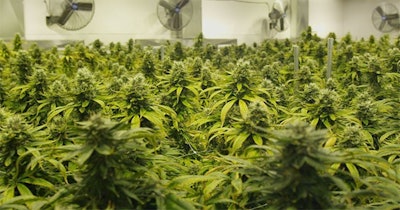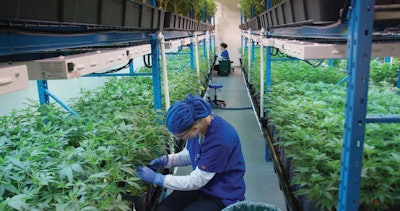
For growers like MedPharm Iowa, the state’s first licensed medical cannabis oil manufacturer, managing odor is part of being a good neighbor and practicing good business. The company’s owners believe odor mitigation is as important to the cannabis industry as it is to their individual capital investment. “One of the reasons we decided to get in this business in the first place was to set the direction for Iowa, rooting our operation in science, research, and developing everything from new growing and extraction methods to product development, based on insights science can give us,” says Lucas Nelson, general manager at MedPharm Iowa, a spin-off of Kemin Industries. (Kemin Industries is an ingredient manufacturer based in Des Moines, Iowa.) “It’s what we’ve done at Kemin for over 60 years, and it’s what we want to do for the cannabis industry.”
The Importance of Planning
One of the most universal tips you’ll receive from experienced growers and industry experts is to plan ahead. It certainly worked for MedPharm.
Early in its facility planning process, the company didn’t receive any regulatory guidance about odor, but midway through the building process—after two construction phases were complete and the HVAC system had been installed—a county air control group presented them with a set of proposed rules.
Those rules could have caused significant construction delays, making MedPharm non-compliant with other state rules, like the state’s mandatory operation date. “If we were not in compliance, then we were looking at having to go back and retrofit some of what we had done,” Nelson says. “Our state wrote the law such that we had to have product on the shelves by Dec. 1, 2018, so as you can imagine, that’s a tight schedule.” MedPharm had roughly a year to build a facility, make it operational, hire staff, and grow and process a final product.
Working with regulators, MedPharm learned that the guidelines were based on rules for outdoor growing in Western states—not for cultivation in a controlled indoor environment. The company was able to work with regulators in crafting more appropriate regulations, and its preparation allowed it to meet the rules that were eventually adopted.
During the planning phase, MedPharm had anticipated how neighbors might feel about odor, drawing on expertise from their mothership, Kemin Industries, which had recently completed a $125-million headquarters in a Des Moines neighborhood where existing odors from tire manufacturing and meat processing were a factor.
“[Planning] benefited us because it showed that we were not trying to cut corners by going the cheapest or simplest way, but staying focused on the future of this industry in the state,” Nelson says. “We want to set a standard that makes sense from a business standpoint, and one that all the people of Iowa, the legislature and other groups can get on board with, and see that we’re not becoming a nuisance, that this [cannabis] is a solution for people seeking relief from pain and other conditions. We didn’t want our message to be clouded by smelling up the south side of Des Moines.”
Every aspect of MedPharm’s grow operation is contained, meaning no flower room air ever meets the outside world. MedPharm’s facility also has an extensive HVAC system that filters all the incoming and outgoing air through carbon.

Seek Knowledgeable Odor Experts
Not every company has the internal expertise MedPharm enjoys through its mature parent company. Growers can easily fill that void with the help of outside experts, according to Reid Parr, chief operating officer (COO) of Ascent Industries, which owns and operates numerous cannabis facilities in Oregon, Nevada and Canada.
“One key thing we did right from the beginning was to hire engineers to create an odor plan for us,” Parr says. He says odor control planning should never be an afterthought. It should begin early in the planning process and be considered in every aspect of a facility’s design.
Much of odor mitigation planning can be coupled with your HVAC preparation. Engineering firms that specialize in odor mitigation will consider things like humidity, temperature and biosecurity needs. “If you’re going to design an HVAC system to clean the air that leaves the facility, it makes a whole lot of sense to be also looking at the air you’re bringing into the facility as part of the same plan,” Parr says.
Ascent facilities uses a custom-engineered odor mitigation system that addresses odor and controls incoming air, which is treated with UV elements to kill any microbes. Only clean air warmed or cooled at the right temperature enters positively pressured grow rooms. Open the door to a grow room, and air billows into secondary common areas, where it is purified with charcoal filters and UV before it’s exhausted outside. “You can stand outside our facility and not smell any cannabis,” Parr says.
When choosing an engineering company, Parr says cannabis cultivators shouldn’t feel locked into dealing with resources that specialize in the cannabis industry. Instead, he says it’s important to look for people who are experts at mitigating odor. “Cannabis is actually fairly low on the list compared to the odor mitigation other industries have to deal with,” Parr says. “There are systems out there that are very effective. They just have to be planned for, invested in and used effectively.”
Site selection is another often-neglected factor. Parr says it’s important to know your local bylaws, your neighbors, weather patterns and how far you’re located from areas of possible concern. “If you’re in an industrial area or an area where there are chicken and pig farms, having cannabis odor is really kind of low on the list,” he says. That’s a far different story if you locate in a commercial industrial space where nearby retail businesses could suffer if customers are offended by odor from cannabis operations.

The Unique Challenge of Outdoor Growing
Befriending your neighbors may be one of the most straightforward ways to avoid odor complaints for outdoor growers, according to Crystal Oliver, president and co-founder of Washington’s Finest Cannabis in Spokane, Wash. Each year, Oliver grows vegetable starts on her land and shares them with neighbors. (Oliver is a member of the Cannabis Business Times editorial advisory board and the 2019 Cannabis Conference advisory board.
“My family also walks around our property and the road near our farm weekly and picks up garbage,” Oliver says. “When our neighbors invite us over for a beer or barbecue, we go. We work very hard to be friends with our neighbors. My feeling is that farms with the most complaints have bad relationships with their neighbors.”
Oliver says strain selection can also play a part in reducing the likelihood of odor complaints. “We’ve always taken terpene profile into consideration when selecting cultivars and have tended to shy away from growing cannabis that has a very ‘skunky’ terpene profile in favor of cultivars high in limonene or geraniol, for example,” she says.
A good location and natural buffers can also be helpful to outdoor growers. Oliver’s farm is located on agricultural land surrounded by neighbors who raise hay, cattle, horses, goats, lavender and more. “Odors and dust are a part of rural living here, so folks don’t tend to complain,” she says.
Surrounding a crop by other natural vegetation can disperse odor, obscure crop visibility and generate fewer complaints—a strategy that’s been successful for poultry and swine operations. Oliver wishes the industry would invest in more research on the subject.
Oliver has been an involved member of the industry, serving on Spokane Regional Clean Air Authority’s Marijuana Advisory Committee, as executive board member of the Cannabis Farmers Council, and as executive assistant of Washington’s National Organization for the Reform of Marijuana Laws (NORML) affiliate. Oliver has analyzed parcels in Spokane County that receive complaints, and developed a theory about what may cause the highest rate of odor complaints, including:
- hoophouse/greenhouse operations that engage in continual harvests,
- farms located on parcels of less than 10 acres, and
- farms located in industrial areas, on hillsides or adjacent to valleys with residences.
Engineered solutions may not be as relevant for outdoor cannabis growers. Some choose to employ ozone generators, but that’s often an imperfect solution because no one can control which way the wind blows or where the ozone lands.



















